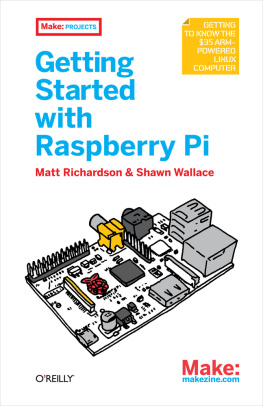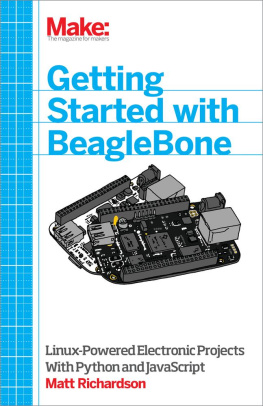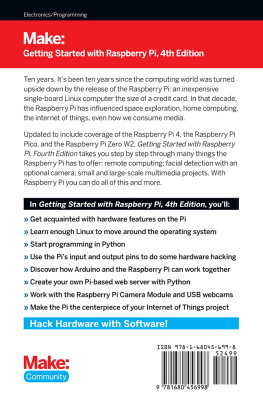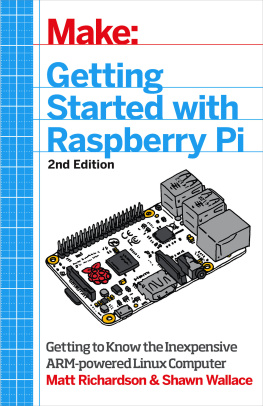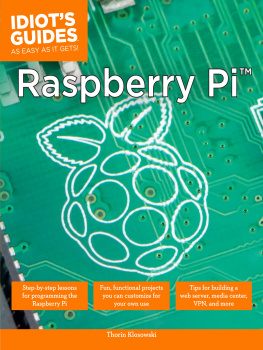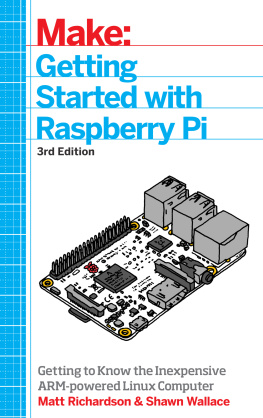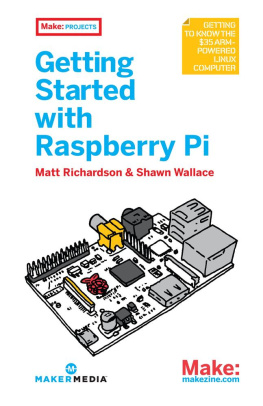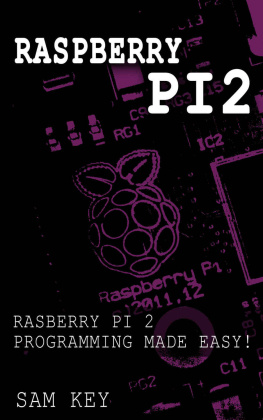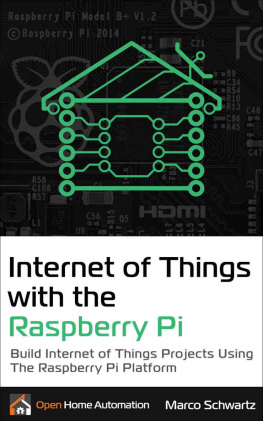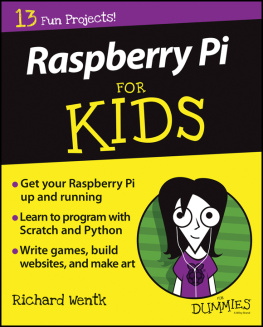Matt Richardson - Getting Started with Raspberry Pi
Here you can read online Matt Richardson - Getting Started with Raspberry Pi full text of the book (entire story) in english for free. Download pdf and epub, get meaning, cover and reviews about this ebook. year: 2012, publisher: OReilly Media, genre: Home and family. Description of the work, (preface) as well as reviews are available. Best literature library LitArk.com created for fans of good reading and offers a wide selection of genres:
Romance novel
Science fiction
Adventure
Detective
Science
History
Home and family
Prose
Art
Politics
Computer
Non-fiction
Religion
Business
Children
Humor
Choose a favorite category and find really read worthwhile books. Enjoy immersion in the world of imagination, feel the emotions of the characters or learn something new for yourself, make an fascinating discovery.
- Book:Getting Started with Raspberry Pi
- Author:
- Publisher:OReilly Media
- Genre:
- Year:2012
- Rating:3 / 5
- Favourites:Add to favourites
- Your mark:
- 60
- 1
- 2
- 3
- 4
- 5
Getting Started with Raspberry Pi: summary, description and annotation
We offer to read an annotation, description, summary or preface (depends on what the author of the book "Getting Started with Raspberry Pi" wrote himself). If you haven't found the necessary information about the book — write in the comments, we will try to find it.
Getting Started with Raspberry Pi — read online for free the complete book (whole text) full work
Below is the text of the book, divided by pages. System saving the place of the last page read, allows you to conveniently read the book "Getting Started with Raspberry Pi" online for free, without having to search again every time where you left off. Put a bookmark, and you can go to the page where you finished reading at any time.
Font size:
Interval:
Bookmark:
Its easy to understand why people were skeptical of the Raspberry Pi when it was first announced.A credit card-sized computer for $35 seemed like a pipe dream.Which is why, when it started shipping, the Raspberry Pi created a frenzy of excitement.
Demand outstripped supply for months and the waitlists for these mini computers were very long.Besides the price, what is it about the Raspberry Pi that tests the patience of this hardware-hungry mass of people?Before we get into everything that makes the Raspberry Pi so great, lets talk about its intended audience.
Eben Upton and his colleagues at the University of Cambridge noticed that todays students applying to study computer science dont have the skills that they did in the 1990s.They attribute this toamong other factorsthe "rise of the home PC and games console to replace the Amigas, BBC Micros, Spectrum ZX and Commodore 64 machines that people of an earlier generation learned to program on."Since the computer has become important for every member of the household, it may also discourage younger members from tinkering around and possibly putting such a critical tool out of commission for the family.But recently mobile phone and tablet processors have become less expensive while getting more powerful, clearing the path for the Raspberry Pis leap into the world of ultra-cheap-yet-serviceable computer boards.As the founder of Linux, Linus Torvalds, said in an interview with BBC News, Raspberry Pi makes it possible to "afford failure."
One of the great things about the Raspberry Pi is that theres no single way to use it.Whether you just want to watch videos and surf the web, or you want to hack, learn, and make with the board, the Raspberry Pi is a flexible platform for fun, utility, and experimentation.Here are just a few of the different ways you can use a Raspberry Pi:
As makers, we have a lot of choices when it comes to platforms on which to build technology-based projects.Lately, microcontroller development boards like the Arduino have been a popular choice because theyve become very easy to work with.But System on a Chip platforms like the Raspberry Pi are a lot different than traditional microcontrollers in many ways.In fact, the Raspberry Pi has more in common with your computer than it does with an Arduino.
This is not to say that a Raspberry Pi is better than a traditional microcontroller; its just different.For instance, if you want to make a basic thermostat, youre probably better off using an Arduino Uno or similar microcontroller for purposes of simplicity.But if you want to be able to remotely access the thermostat via the web to change its settings and download temperature log files, you should consider using the Raspberry Pi.
Choosing between one or the other will depend on your projects requirements and in fact, you dont necessarily have to choose between the two.In , well show you how to use the Raspberry Pi to program the Arduino and get them communicating with each other.
As you read this book, youll gain a better understanding of the strengths of the Raspberry Pi and how it can become another useful tool in the makers toolbox.
But Wait Theres More!
Theres so much you can do with the Raspberry Pi, we couldnt fit it all into one book.Here are a few other ways you can use it:
Your typical computer is running an operating system, such as Windows, OS X, or Linux.Its what starts up when you turn your computer on and it provides your applications access to hardware functions of your computer.For instance, if youre writing a application that accesses the Internet, you can use the operating systems functions to do so.You dont need to understand and write code for every single type of Ethernet or WiFi hardware out there.
Like any other computer, the Raspberry Pi also uses an operating system and the "stock" OS is a flavor of Linux called Raspbian .Linux is a great match for Raspberry Pi because its free and open source.On one hand, it keeps the price of the platform low, and on the other, it makes it more hackable.And youre not limited to just Raspbian, as there are many different flavors, or distributions , of Linux that you can load onto the Raspberry Pi.There are even a few non-Linux OS options available out there.Throughout this book, well be using the standard Raspbian distribution thats available from Raspberry Pis download page.
If youre not familiar with Linux, dont worry, will equip you with the fundamentals youll need to know to get around.
When you have access to an exciting new technology, it can be tough deciding what to do with it.If youre not sure, theres no shortage of interesting and creative Raspberry Pi projects out there to get inspiration from.As editors for MAKE, weve seen a lot of fantastic uses of the Raspberry Pi come our way and we want to share some of our favorites.
Font size:
Interval:
Bookmark:
Similar books «Getting Started with Raspberry Pi»
Look at similar books to Getting Started with Raspberry Pi. We have selected literature similar in name and meaning in the hope of providing readers with more options to find new, interesting, not yet read works.
Discussion, reviews of the book Getting Started with Raspberry Pi and just readers' own opinions. Leave your comments, write what you think about the work, its meaning or the main characters. Specify what exactly you liked and what you didn't like, and why you think so.

